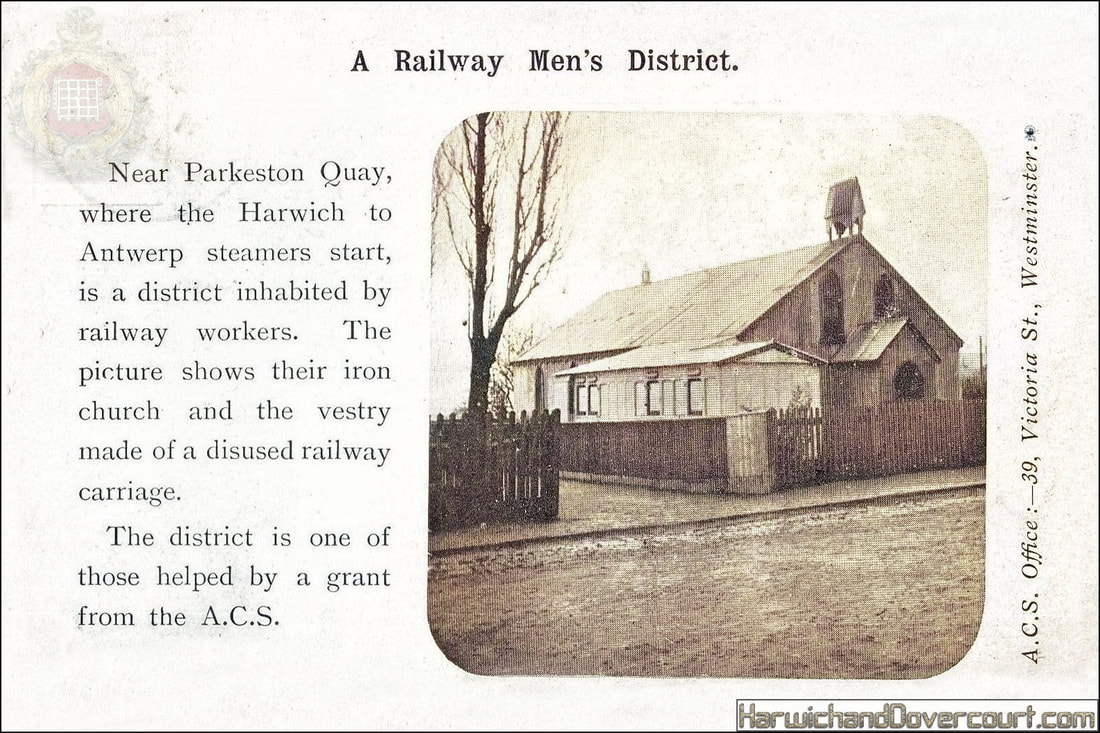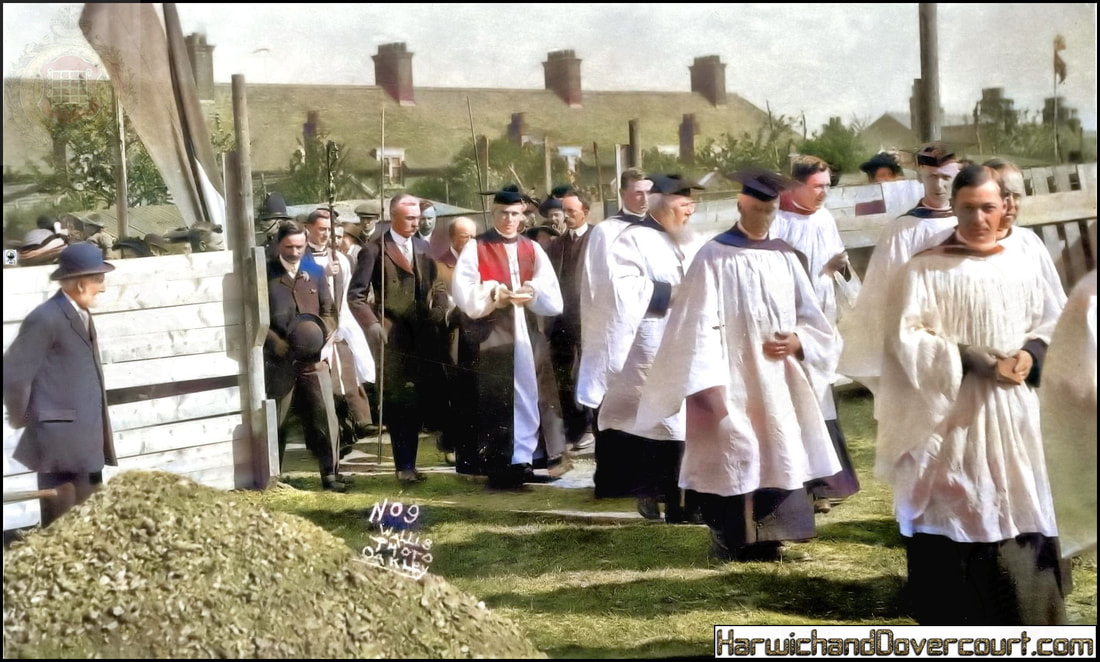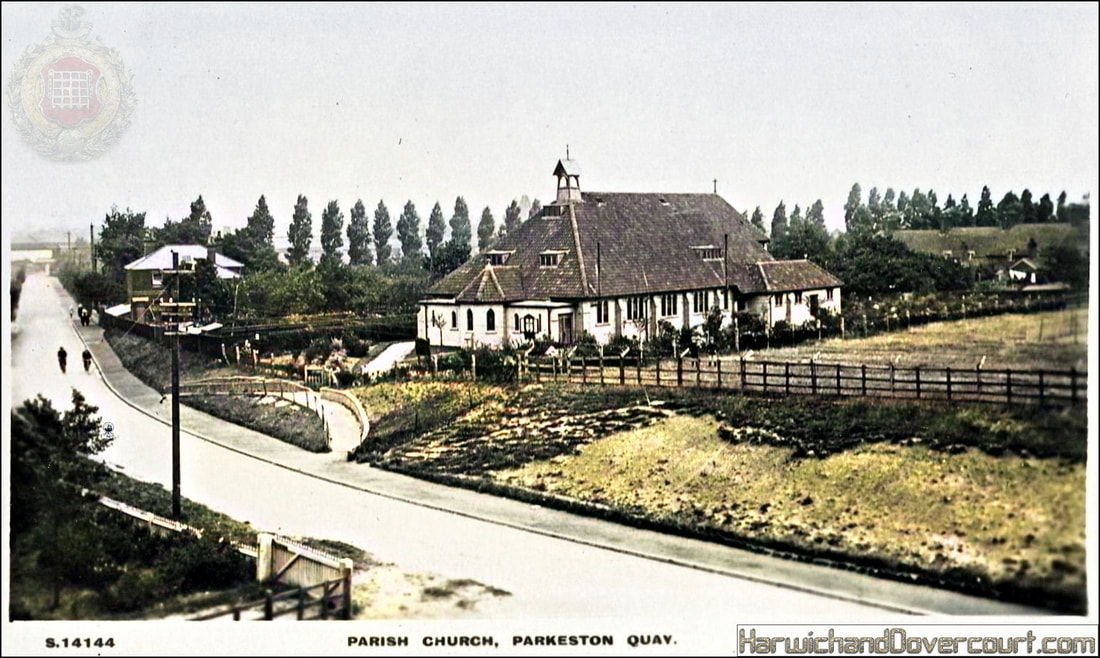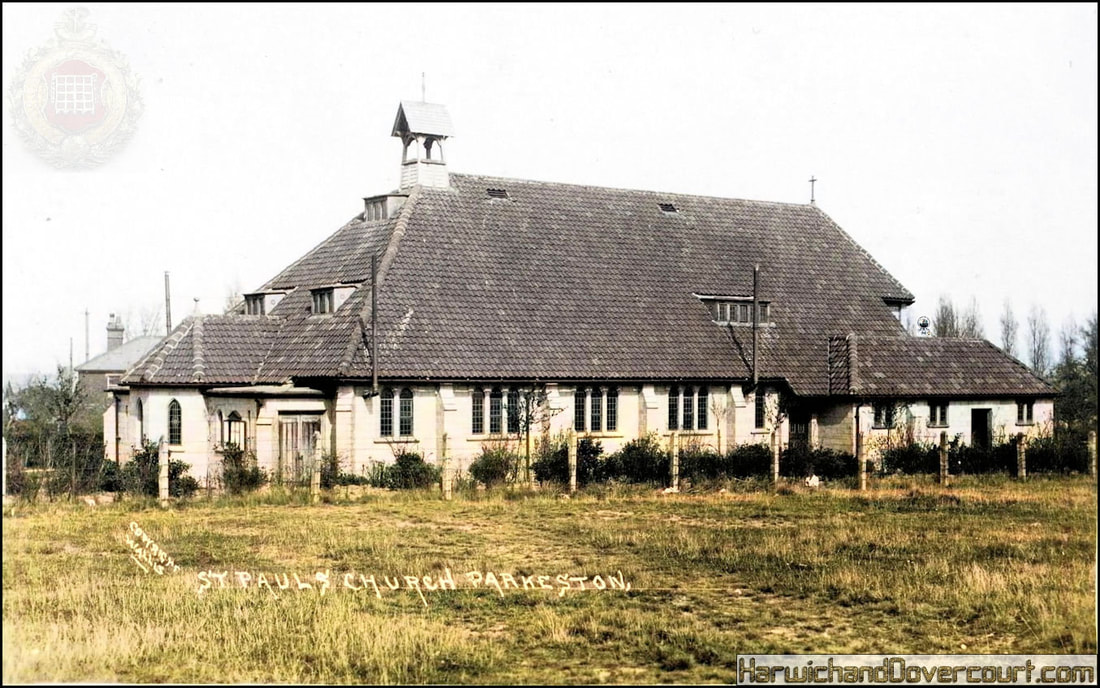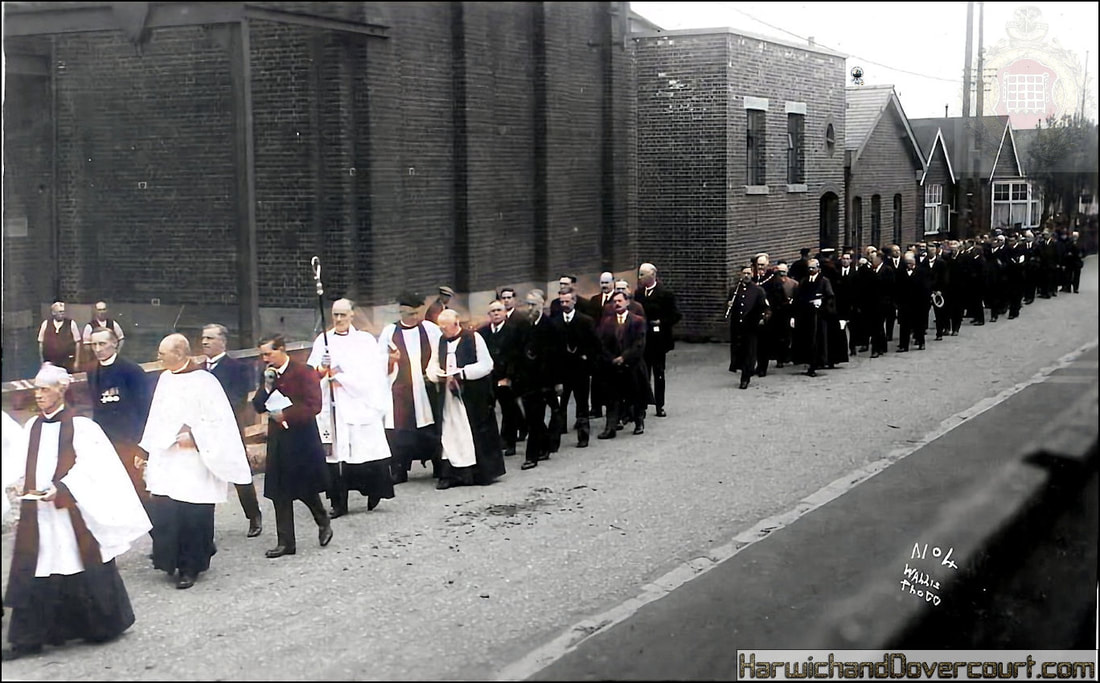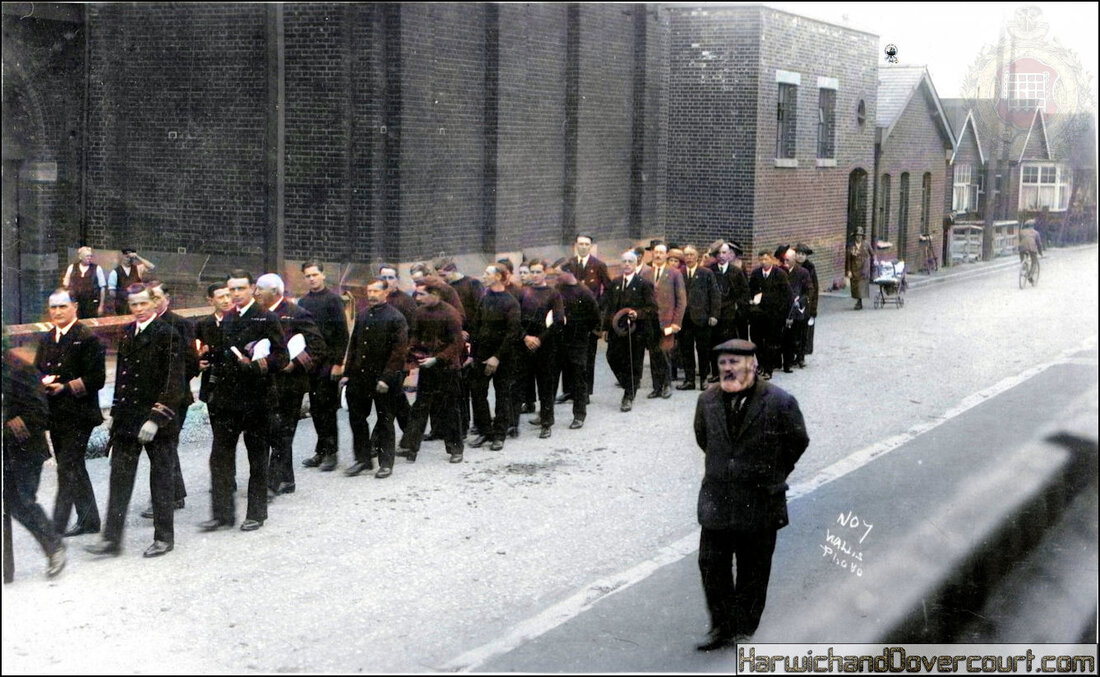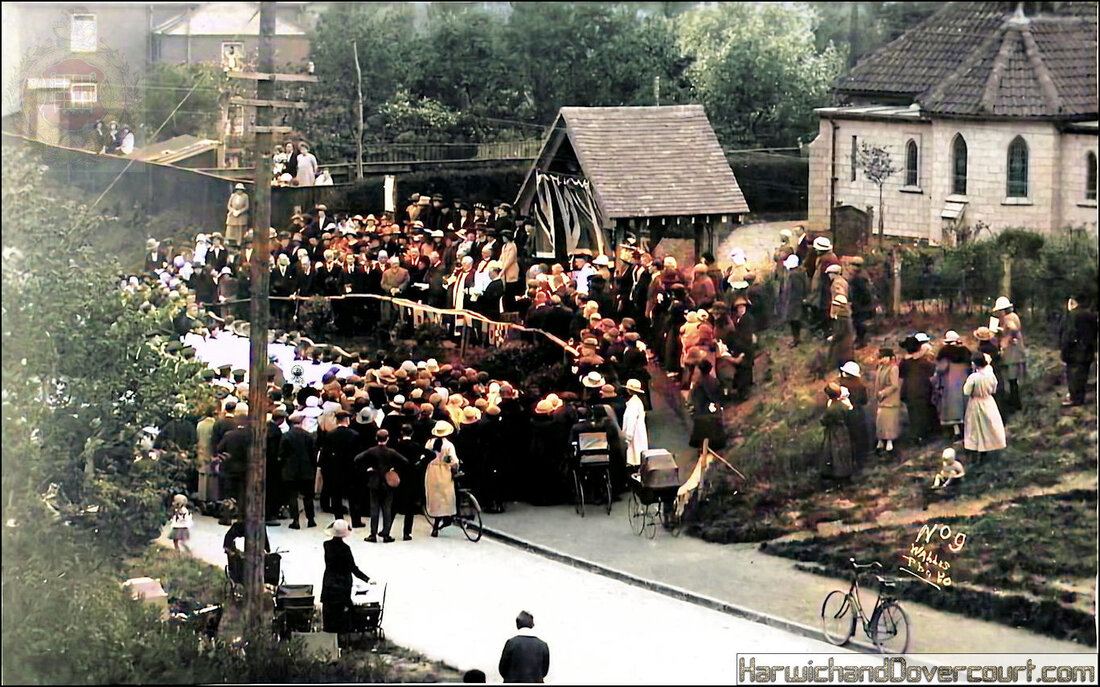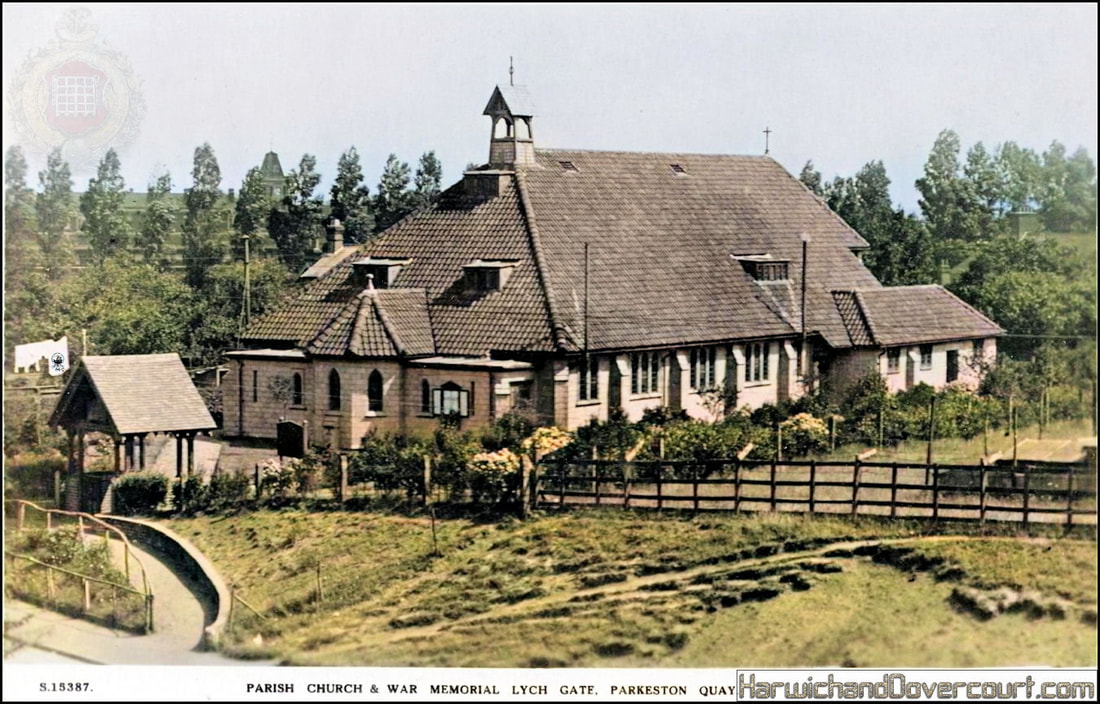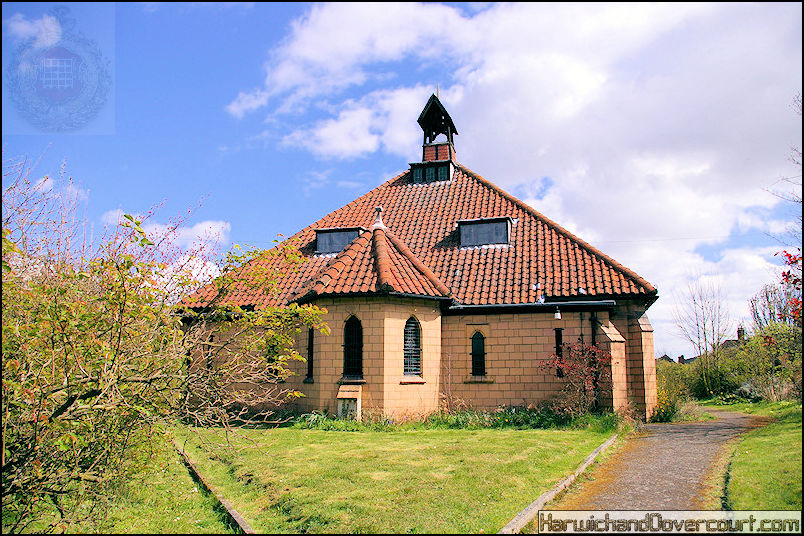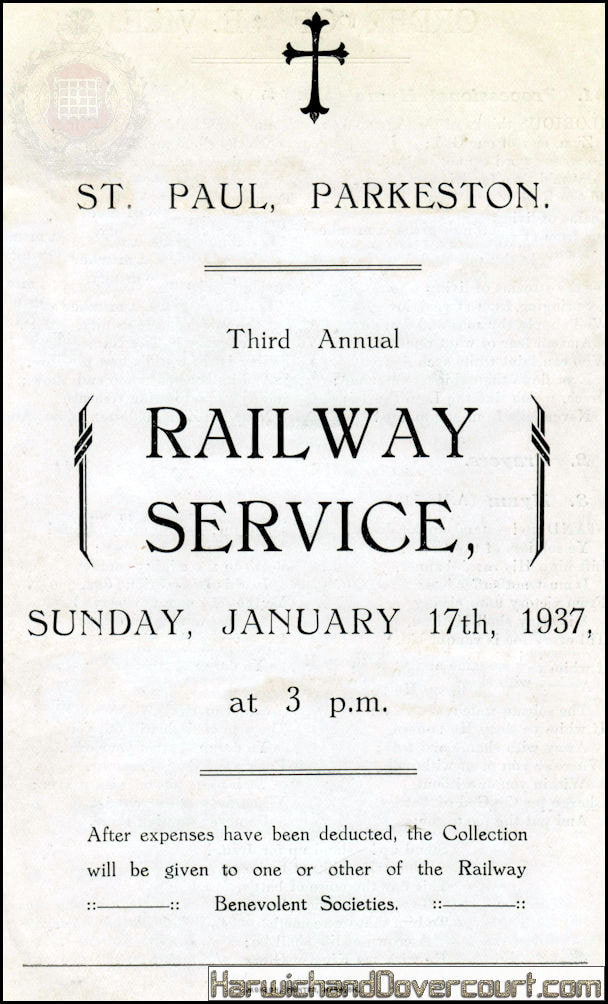St Gabriel's Church, Parkeston, Essex.
01 S 4165 Parkeston Church (1909) H&D FW
St Gabriel's : History of the "Iron Church" the Railway Men's District Church
The so called “The Tin Tabernacle” was opened on the 13th June 1887, in Queen Victoria's Jubilee Year.
The "Iron" church and the vestry made from a disused railway carriage also had it's own organ purchased with donations from three anonymous directors in memory of the crew of the “Berlin” who had lost their lives in the 1907 disaster. The organ was later transferred to St Paul's Church.
The church was finally demolished in 1973 to make way for the current railway club.
The so called “The Tin Tabernacle” was opened on the 13th June 1887, in Queen Victoria's Jubilee Year.
The "Iron" church and the vestry made from a disused railway carriage also had it's own organ purchased with donations from three anonymous directors in memory of the crew of the “Berlin” who had lost their lives in the 1907 disaster. The organ was later transferred to St Paul's Church.
The church was finally demolished in 1973 to make way for the current railway club.
02 St Gabriel's. Parkeston, Essex ~ A Railway Man's District (1912) H&D FW
St Paul's Church, Parkeston, Essex.
St Paul's Church : The History
St Paul’s Church in Makins Road, was built in 1914, close to the Main Road on land granted to the church by the Great Eastern Railway Board in 1909. It was dedicated to St.Paul and had provision for a congregation of 350 people. The organ was originally sited in St.Gabriel’s church but was transferred to St.Paul’s, originally dedicated to the passengers and crew who lost their lives in the S S Berlin disaster in 1907.
The church finally closed to public worship on January 26th 1914, a date that marked almost a hundred years of St Paul’s with a final service that celebrated this. Vandalism and lead theft, left the building in a poor state of repair, which the church committee could not afford to fix.
It was sold for £125,000.
St Paul’s Church in Makins Road, was built in 1914, close to the Main Road on land granted to the church by the Great Eastern Railway Board in 1909. It was dedicated to St.Paul and had provision for a congregation of 350 people. The organ was originally sited in St.Gabriel’s church but was transferred to St.Paul’s, originally dedicated to the passengers and crew who lost their lives in the S S Berlin disaster in 1907.
The church finally closed to public worship on January 26th 1914, a date that marked almost a hundred years of St Paul’s with a final service that celebrated this. Vandalism and lead theft, left the building in a poor state of repair, which the church committee could not afford to fix.
It was sold for £125,000.
03 Blessing of the Ground for St Pauls Church, Parkeston (1914) Wallis C FW
No 9 ~ The Dedication of St Paul's Church, Parkeston, Essex (30th October 1914) by Walls.
Leading the procession of clergy, choirs, bishops and local dignitaries is the Bishop of Chelmsford, walking in from Mankins Road, Parkeston. This "Dedication" was actually a "blessing" of the land upon which the church was built. The church was designed by E Douglas Hoyland and constructed by a local company "Fisher & Woods". Funding was by subscriptions of £180, as well as a large single donation of £200 from Lord Claude Hamilton, who was also Chairman of the Great Eastern Railway & M.P for Kensington South (Lord Hamilton had also laid the foundation stone of the St Paul's Church, earlier in the year on Saturday May 2nd 1914.).
The church itself could seat 350 people and was built with yellow terracotta brickwork, while the organ inside was bought from the original "Iron Church" St Gabriel’s Church in Hamilton Street. The church was built on land granted by the Great Eastern Railway, but after 100 years of service, held its final service on the Sunday 26th Jan 2014. A survey after it closed its doors after the service, found repair costs made it financially unviable (repairs were in the region of £200,000, after vandalism and lead theft from the building) eventually it was put up for sale for £125,000, eight months after the final service.
When the decision was taken, not to reopen St Paul's Church, in Parkeston, the fate of the historic organ and the rolls on honour from the First and Second World War were uncertain. Consideration was being given to dismantling the organ for spare parts but, fortunately, the Harwich Society was approached and the celebrated items were given a new home in the Redoubt Fort, in Harwich.
The organ is of great historic significance as it is a memorial to all of those who lost their lives in the shipping disaster that saw the loss of the Parkeston based passenger ferry, SS Berlin, as she attempted to enter the Hook of Holland during a storm on February 21, 1907. A total of 128 souls were lost making it the worst shipping disaster experienced by the Great Eastern Railway Company. The organ was built in 1912 as a memorial to this disaster and was originally installed in St Gabriel’s Church, in Parkeston, before being moved to St Paul’s on its completion in 1914.
Leading the procession of clergy, choirs, bishops and local dignitaries is the Bishop of Chelmsford, walking in from Mankins Road, Parkeston. This "Dedication" was actually a "blessing" of the land upon which the church was built. The church was designed by E Douglas Hoyland and constructed by a local company "Fisher & Woods". Funding was by subscriptions of £180, as well as a large single donation of £200 from Lord Claude Hamilton, who was also Chairman of the Great Eastern Railway & M.P for Kensington South (Lord Hamilton had also laid the foundation stone of the St Paul's Church, earlier in the year on Saturday May 2nd 1914.).
The church itself could seat 350 people and was built with yellow terracotta brickwork, while the organ inside was bought from the original "Iron Church" St Gabriel’s Church in Hamilton Street. The church was built on land granted by the Great Eastern Railway, but after 100 years of service, held its final service on the Sunday 26th Jan 2014. A survey after it closed its doors after the service, found repair costs made it financially unviable (repairs were in the region of £200,000, after vandalism and lead theft from the building) eventually it was put up for sale for £125,000, eight months after the final service.
When the decision was taken, not to reopen St Paul's Church, in Parkeston, the fate of the historic organ and the rolls on honour from the First and Second World War were uncertain. Consideration was being given to dismantling the organ for spare parts but, fortunately, the Harwich Society was approached and the celebrated items were given a new home in the Redoubt Fort, in Harwich.
The organ is of great historic significance as it is a memorial to all of those who lost their lives in the shipping disaster that saw the loss of the Parkeston based passenger ferry, SS Berlin, as she attempted to enter the Hook of Holland during a storm on February 21, 1907. A total of 128 souls were lost making it the worst shipping disaster experienced by the Great Eastern Railway Company. The organ was built in 1912 as a memorial to this disaster and was originally installed in St Gabriel’s Church, in Parkeston, before being moved to St Paul’s on its completion in 1914.
04 St Paul's Church, Foundation Stone, Parkeston (1914) F CIII
Laying the foundation stone of the St Paul's Church, Parkeston, Essex (1914)
Surrounded by clergy, choirs & bishops, Lord Claude Hamilton, Chairman of the Great Eastern Railway & M.P for Kensington South, is seen here laying the foundation stone of the St Paul's Church in 1914, Makins Road, Parkeston, on Saturday May 2nd 1914. The 103 year-old church was built on land granted by the Great Eastern Railway, but after 100 years of service, held its final service on the Sunday 26th Jan 2014. A survey after it closed, found repair costs made it financially unviable (repairs were in the region of £200,000, after vandalism & lead theft from the building) eventually it was put up for sale for £125,000, eight months after the final service.
Surrounded by clergy, choirs & bishops, Lord Claude Hamilton, Chairman of the Great Eastern Railway & M.P for Kensington South, is seen here laying the foundation stone of the St Paul's Church in 1914, Makins Road, Parkeston, on Saturday May 2nd 1914. The 103 year-old church was built on land granted by the Great Eastern Railway, but after 100 years of service, held its final service on the Sunday 26th Jan 2014. A survey after it closed, found repair costs made it financially unviable (repairs were in the region of £200,000, after vandalism & lead theft from the building) eventually it was put up for sale for £125,000, eight months after the final service.
05 S.14144 Parish Church, Parkeston Quay (1918) H&D FW
The Parish Church
St Paul’s Church, Makins Road, Parkeston.
St Paul’s Church, Makins Road, Parkeston.

